Main Menu
Welcome
In the Nature paper entitled "Mechanism of phototaxis in marine zooplankton" (req. subscr.), Gaspar tells us the whole story in magnificent detail, full color and almost as fascinating and exciting as in his talk last year. These larvae are planktonic, moving around in the sea using a ring of cilia, beating to propel the animals forward. In the early larval stage, they move towards the light (positive phototaxis), moving them away from the place where they hatched (dispersal). Later in their development, they become negatively phototactic. This behavior brings them back to the ocean floor, where they metamorphose into the adult worm (probably quite some ways away from the place where they first hatched).
The animals look sort of like an egg with hair (I'll refrain from alluding to any resemblance to living or fictional characters):
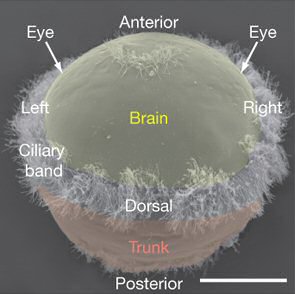
The larva also has two eyes on the bald spot above the 'hairs'.
It uses the cilia ("hairs") to generate a stream of water from front to back, propelling it through the water. Apparently, in the dark the animals move about randomly.
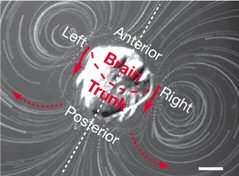
When there is a light source, the two eyes of the larva can detect the direction from which the light is coming. The right eye detects light from the right and the left eye light from the left. Each eye has a shielding pigment to the center of the animal, to prevent light from the opposite direction from exciting the photoreceptor in each eye.
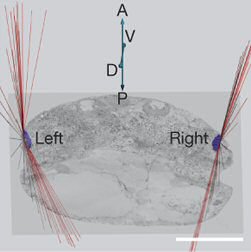
The photoreceptor of each eye makes a direct, inhibitory synaptic connection to the most nearby ciliated cells:
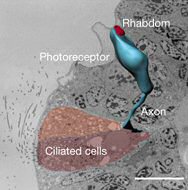
This means that whenever the photoreceptor detects light, it will inhibit the ciliated cells nearby, causing the cilia to beat with a lower frequency. In the graph below, all the cells are numbered around the equator of the larva, with cells #6 and #7 being closest to the eye.
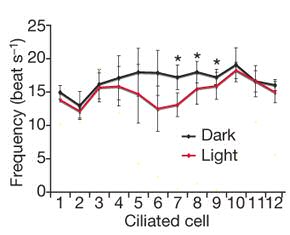
As you can see, in the dark, the frequency of the cilia in beats per second is significantly higher close to the eye, compared to when light is being shone on the larva.
This reduction in ciliary frequency has the same effect as if you'd stop rowing on one side when you're on a lake, rowing: you turn towards the side where you stopped rowing. In much the same way, the larvae turn towards the light, by inhibiting the ongoing activity of the propelling cilia on the side on which there is light.
Gaspar and his colleagues used a wide variety of methods including evolutionary biology, physiology, microscopy, behavioral biology and computer modelling to come to a truly astoundingly detailed conclusion as to how these animals perform directed orientation maneuvers with very few nerve cells. The level of detail, sophistication and rigor in this publication is exceptional.
Superficially, what this fantastic work of science shows is how a stimulus (light) elicits a response (phototaxis) via sensorimotor processes. However, if you look at the physiology of how the larvae are actually performing the behavior, it becomes clear that this appearance is not supported by the data presented in this paper. It's not like the larvae are passively waiting for the light to appear and then switch on phototaxis. Instead, Platynereis larvae generate ongoing behavior even in the absence of light. If the experimenter, the rotation of the earth or their own behavior leads to activation of the eye(s) by light, this light-stimulus only modulates (in this particular case even inhibits) the behavior that was already present before any stimulation. Thus, the general organization of the Urbilaterian nervous system was not characterized by sensorimotor, but by the inverse, motor-sensory, if you will, processes. In the beginning was the behavior, dispersing the larvae. Only later, sensory processing started to provide an evolutionary advantage by modulating the behavior and directing the animal first towards light and then away from light.
These results contrast with most neuroscientific research today which works under the assumption of the sensorimotor hypothesis, stating that the main function of brains is to produce behavior in response to sensory stimulation. This new research suggests that at least the ancestral state was the reverse: brains are generating behavior and then await the response of the environment.
Jékely, G., Colombelli, J., Hausen, H., Guy, K., Stelzer, E., Nédélec, F., & Arendt, D. (2008). Mechanism of phototaxis in marine zooplankton Nature, 456 (7220), 395-399 DOI: 10.1038/nature07590
Posted on Monday 13 July 2009 - 21:19:01 comment: 0
{TAGS}
{TAGS}
You must be logged in to make comments on this site - please log in, or if you are not registered click here to signup
Render time: 0.0855 sec, 0.0056 of that for queries.





